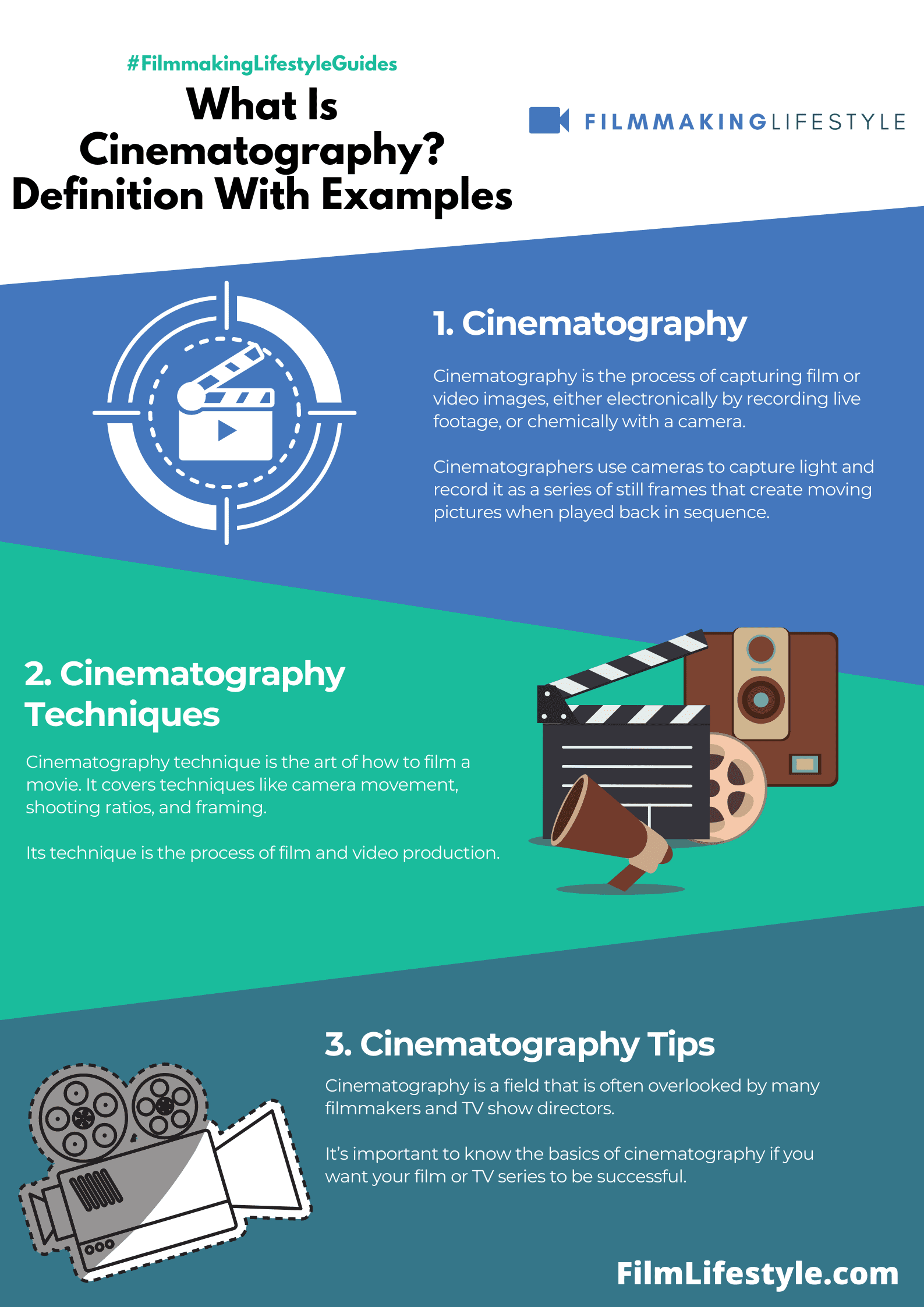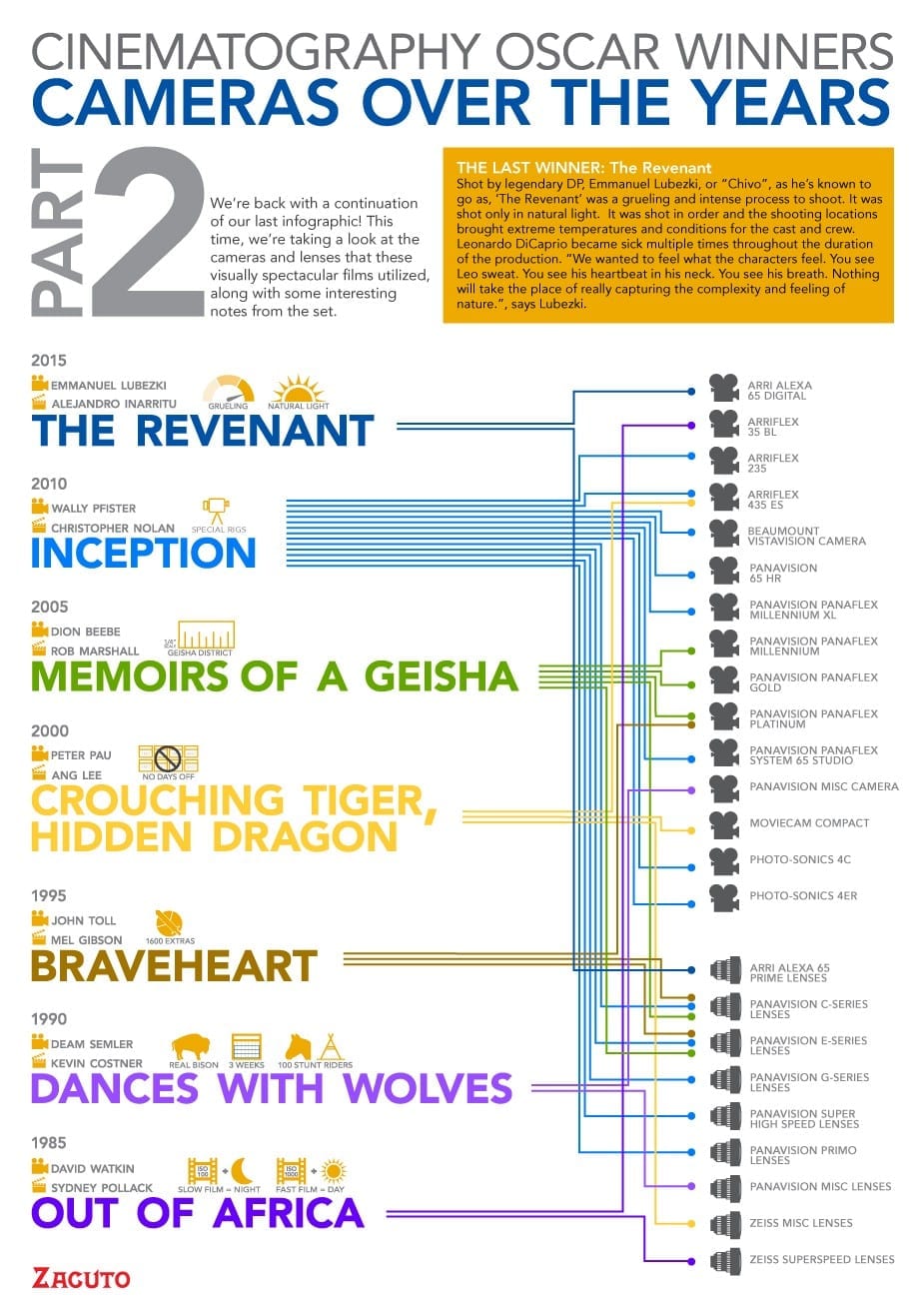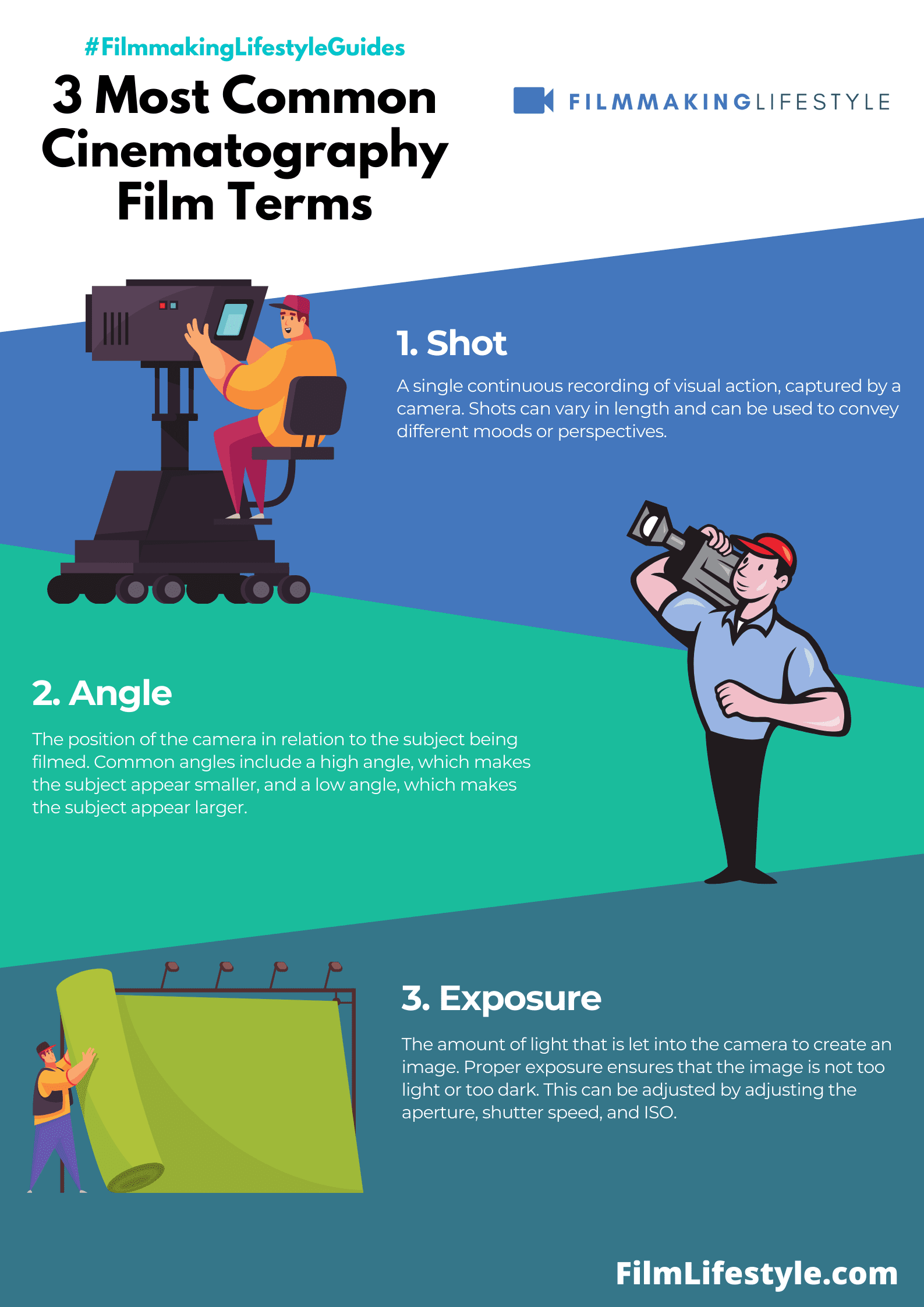Cinematography, or filmmaking, is the process of capturing moving images on a camera.
This includes recording an event as it progresses in time and assembling the recorded pieces into a coherent sequence.
A cinematographer (or director of photography) has to be mindful of what type of lens they are using for each scene and how much light it is available.
It’s not enough to just have great shots. These shots need to work together for them to create what we know as “cinema”.
Have you ever wondered what cinematography is?
It’s the process of capturing and creating footage for movies, video games, commercials, or television programs.
But how does it work? That’s where this article comes in. Hit the music!
WHAT IS CINEMATOGRAPHY
What Is Cinematography?
Cinematography is the process of capturing film or video images, either electronically by recording live footage, or chemically with a camera.
Cinematographers use cameras to capture light and record it as a series of still frames that create moving pictures when played back in sequence.
It’s about framing, composition, movement, camera angles, staging, and lighting. Cinematography strives to be invisible so that all attention can be focused on what is being filmed without distractions.
Cinemagraphs are a mesmerizing blend of photography and video, capturing moments with a hint of motion that’s sure to captivate.
They’re not quite photos and not quite videos, but they hold the power to tell a story in a single, subtle loop.
We’ll jump into what makes cinemagraphs so unique and how they’re changing the way we think about visual storytelling.
Stick with us as we explore how to create these living images and why they’ve become a hot trend in digital marketing and beyond.
What Are Cinemagraphs?
Cinemagraphs sit at the crossroads of photography and video, merging the best of both worlds to create a hybrid visual.
The core of a cinemagraph is a high-quality photograph that exhibits a repeated minor motion – a flicker of a candle flame, the sway of hair in the breeze, or the ripple of water.
These subtle movements are looped seamlessly, often resulting in a mesmerizing effect that captures viewers’ attention in a way that traditional static images or full-motion videos might not.
To really grasp their impact, it’s essential to understand the attributes that make cinemagraphs stand out in the crowded digital space:
- They focus on a single, living moment, making them remarkably potent for storytelling.
- The motion is often restricted to a specific part of the image – it’s these isolated movements that draw the eye and highlight the narrative within.
- Cinemagraphs loop infinitely, creating an illusion of endless motion without the need for a start or finish, which can make them feel timeless.
At their core, cinemagraphs are a compelling tool for visual communication.
They hold the static nature of a snapshot while breathing life into the picture with a hint of motion.
It’s a combination that is hard to ignore and even harder to forget.
As aficionados of photography and champions of creative expression, we’re excited to see how artists and marketers continue to push the boundaries with this innovative format.
Filmmaking Lifestyle celebrates these unique creations that have elevated the way stories are told – one frame, one loop, one moment at a time.
The Unique Blend Of Photography And Video
Cinemagraphs emerge at the intersection of photography and video, two mediums steeped in artistic tradition and technological innovation.
As experts, we often find ourselves enthralled by the seamless fusion these creations offer – they’re not just images or videos but something entirely new and captivating.
A cinemagraph is like a living photograph.
It preserves the timelessness of a still image while incorporating the dynamism of motion.
The blend is so natural that viewers might not notice the movement at first glance.
Yet once seen, the effect is unforgettable, as parts of the scene come to life in a loop that’s both hypnotic and subtle.
Here are some key features that define cinemagraphs:
- They usually isolate movement in a part of the image while the rest remains still.
- The motion is looped flawlessly, making it nearly impossible to detect the beginning or end.
- They often evoke stronger emotional responses than static images due to their unexpected and captivating movement.

A cinemagraph can highlight the steam rising from a cup of coffee in a still café or the flickering of flames in an otherwise frozen campfire scene.
It’s these minute motions that draw the viewer’s eye and invite them to linger, creating a story within a single frame.
Crafting cinemagraphs requires a precise balance – too much movement and the magic is lost; too little and the effect might be missed.
As visual storytellers at Filmmaking Lifestyle, our approach is to keep the motion subtle yet integral, an approach that honors the essence of the scene.
It’s through this synergy of photography and video that cinemagraphs bind viewers in a moment.
They’re more than just a novelty; they represent the evolution of visual storytelling – part photo, part video, and wholly mesmerizing.
Exploring The Power Of Visual Storytelling
Visual storytelling is an art form that’s been evolving for centuries, from the cave paintings of our ancient ancestors to today’s digital masterpieces.
Cinemagraphs represent the next leap in this evolution – a crossroads where photography meets video, and where each frame can tell a story far more profound than words alone.
As artists and creators, we understand that emotion is a critical component of visual narratives.
Cinemagraphs elevate this by introducing an element of surprise through their living motion.
This subtle animation draws the viewer in and holds their attention, leaving an impression that lasts far beyond the initial glance.

Here’s what makes them so powerful in storytelling:
- They capture the essence of a moment – expressing a depth of story and emotion impossible to convey with a single, static image.
- The looped motion creates a hypnotic effect, highlighting key components of a narrative without the need for a full-motion video.
- Heightened engagement is achieved as viewers are compelled to decipher the story that unfolds within the cinemagraph’s frame.
Consider classics like The Great Gatsby or modern hits like Stranger Things.
Imagine the roaring ’20s or the eerie unknown represented not just through descriptive language, but through cinemagraphic moments that linger in the collective memory of viewers.

This is the transformative power of cinemagraphs in visual storytelling.
We’re on a quest to enrich the palette of visual communication and cinemagraphs are one of our favorite tools.
They’re not just a technique for us at Filmmaking Lifestyle, they’re a passion.
As the world grows increasingly visual and attention spans shorten, the ability to captivate and convey complex narratives through a single looping moment is more than impressive — it’s essential.
How To Create Cinemagraphs
Creating mesmerizing cinemagraphs doesn’t have to be an arduous process.
With a blend of keen artistic vision and a few technical steps, we can bring static images to life.
Firstly, the process begins with capturing a high-quality video.
Look for scenes with potential for perpetual motion – such as flowing water, swaying trees, or a bustling cityscape.
Consider composition and framing, as these are crucial in cinemagraph creation, much like in traditional photography.
Next, import your footage into a video editing software.
Programs like Adobe
Then meticulously trim the clip to highlight the segment where motion occurs most naturally.
The editing phase is where the magic happens:
- Isolate the moving element using masking tools,
- Ensure that the loop is seamless – this might involve adjusting the speed or blending frames,
- Finalize by exporting the cinemagraph in a format that supports animation, like GIF or MP4.
Remember, the key to a successful cinemagraph is subtlety – the movement should be just enough to surprise and captivate without overwhelming the viewer.
Our advice is to experiment with different elements and motion to see what creates the most engaging effect.
Selecting the right tools and techniques is essential for refining your cinemagraphs.
Seek inspiration from existing works and don’t be afraid to push the boundaries of this dynamic art form.
With practice, we can make cinemagraphs that not only enhance our storytelling but also leave a lasting impression on our audience.
The Rising Trend In Digital Marketing And Beyond
Cinemagraphs have quickly made their mark in digital marketing as a way to grab and sustain viewer attention.
In an age where consumers are bombarded with static images daily, the captivating nature of a subtle motion in a photograph can be a game-changer.
We’ve noticed major brands incorporate cinemagraphs into their campaigns, using platforms like Facebook and Instagram to showcase their products in a fresh, engaging way.
The allure of cinemagraphs extends beyond marketing, infusing life into various digital experiences.
We find them enhancing:
- Web Design – Cinemagraphs provide an aesthetic edge on homepages, captivating visitors the moment they land on a site,
- Email Campaigns – Breaking through the clutter of the inbox, they boost click-through rates by adding a hint of intrigue,
- Social Media – They increase engagement rates, encouraging shares and comments by stopping users in their tracks.
The results speak for themselves.
Data from marketing campaigns show that cinemagraphs tend to outperform still imagery.
We see higher engagement rates, longer view times, and a boost in overall conversion rates.
Companies leveraging this medium often report significant upticks in consumer interest and interaction.
Cinemagraphs are not just for big brands.
We see a growing number of bloggers, influencers, and small businesses employing this technique to tell their stories in more compelling ways.
Tools and apps have made it easier for anyone to create and share their own cinemagraphs.
The barrier to entry is lower than ever, making this innovative format accessible to a wider audience.
What’s clear is that whether you’re a marketer, content creator, or storyteller, we’re only scraping the surface of what’s possible with cinemagraphs.
The potential for engagement and connection through these moving images is vast and we’re excited to continue exploring this fascinating intersection of photography and video.
What Is Cinemagraphs – Wrap Up
We’ve witnessed the captivating allure of cinemagraphs and their role in setting new standards for visual storytelling.
Their seamless integration across various digital platforms has proven to be a game-changer for marketers and creatives alike.
With the ease of creating these living photos, we’re excited to see how they’ll continue to evolve and enrich our digital experiences.
Let’s embrace the magic of cinemagraphs and the dynamic edge they bring to our visual narratives.
Frequently Asked Questions
What Are Cinemagraphs?
Cinemagraphs are a type of visual media that combine a still photograph with a minor, repeating movement, creating a looping video that is visually arresting.
They capture viewer attention by appearing almost magical, as most of the image stays still while one or more elements move subtly.
Why Are Cinemagraphs Popular In Digital Marketing?
Cinemagraphs are popular in digital marketing because they stand out in a sea of static images, engaging viewers more effectively.
Their unique appearance can increase the time users spend looking at content, leading to higher engagement and conversion rates, making them a valuable tool for marketers.
How Do Cinemagraphs Improve Engagement Rates?
Cinemagraphs improve engagement rates by drawing the viewer’s eye to the motion within a largely static image, which increases the likelihood of viewers stopping to look and interact with the content.
This increased viewer interaction leads to better engagement metrics.
Can Cinemagraphs Be Used In Email Campaigns?
Yes, cinemagraphs can be used in email campaigns.
They add a dynamic element to otherwise static emails, potentially increasing click-through rates and overall engagement by capturing the recipient’s attention more effectively than traditional images.
What Tools Can I Use To Create Cinemagraphs?
There are various tools and apps available for creating cinemagraphs, such as Flixel, Adobe
These tools vary in complexity, allowing for both beginners and professionals to create engaging cinemagraphs.
Are Cinemagraphs Better Than Static Images?
Cinemagraphs often perform better than static images in terms of engagement because they offer a visual hook that static images may lack.
While not inherently better in every situation, they can be more captivating and therefore beneficial for marketing campaigns seeking higher viewer interaction.


